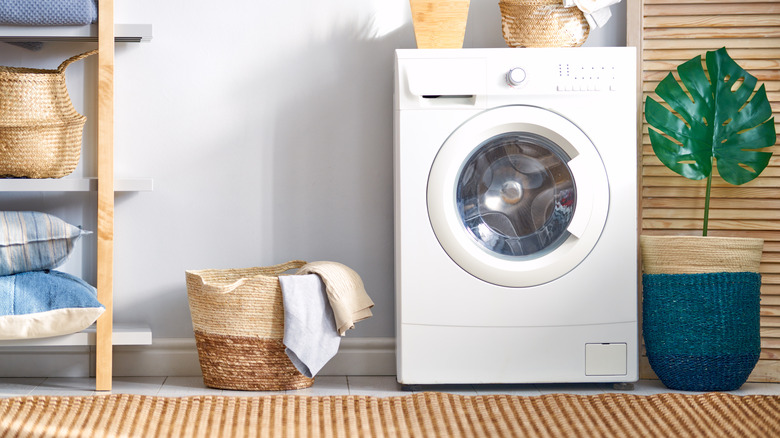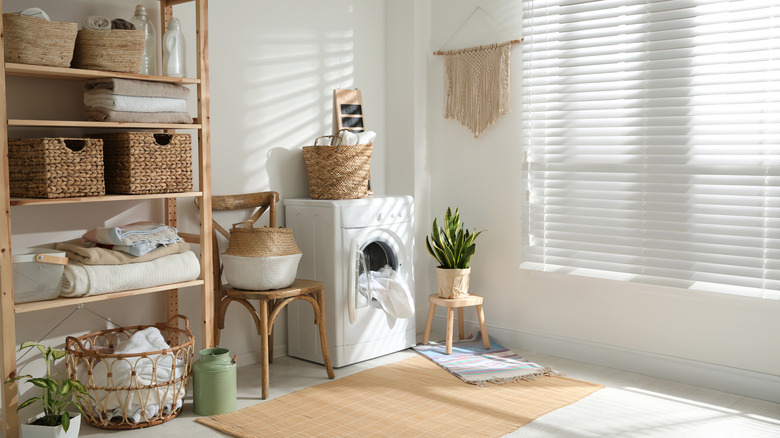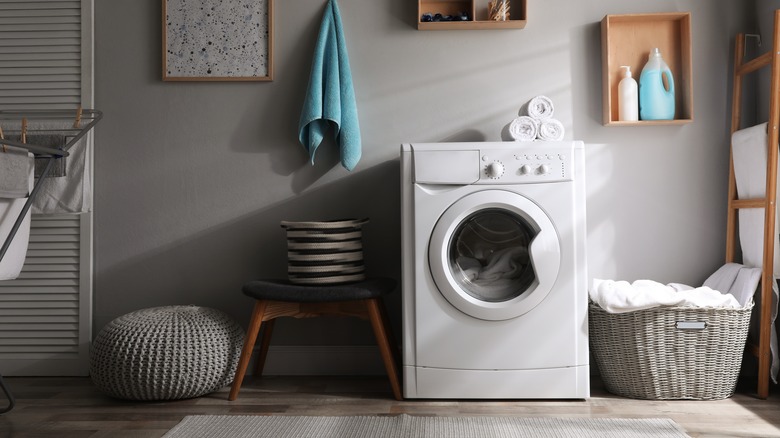The Genius Reason You Should Add Soft Accessories To A Loud Laundry Room
We may receive a commission on purchases made from links.
Your laundry room is a hub of activity, but with that comes noise. Between wash cycles and the dryer, this space can become a cacophony of sound that can be hard to drown out when laundry day comes around. Just by adding a few soft accessories in this loud but necessary area, you can limit some of the volume your machines produce and soften the intensity of your loads. Rather than having to fight to be heard over a spin cycle, use some downy textures in the room, which will absorb some of the noise and thereby diminish the loud sounds in your space. Soft accessories can be added through functional items like rugs and curtains or purely-decorative pieces like wall tapestries and throw pillows.
It is unlikely you'll be able to fully block out the noise from your laundry room without actually soundproofing the whole space (sigh), but using thick, plush items can help reduce the loud sounds that emanate from your machines. As they run, your washer and dryer can emit bumps, thunks, and other noises that then bounce off the floor and hard surfaces around the space (including the walls), ensuring that you hear them in another room of the home. Using anything from seating cushions to rugs can help to create a small sound barrier that keeps bangs and whirs to a minimum.
How soft accessories help absorb noise
Because sound is emitted through vibrations, items like your washer and dryer can project loud noises, since they are constantly vibrating while in use. The washer also produces loud sounds during the spin cycle, which is completed before the end of a wash to remove enough water so that the items can be transferred to the dryer. And, loud sounds can also be heard in the dryer if zippers and buttons clack against the drum. To fix this problem, soft home decor can be placed around the space to absorb the reverberations before they can hit the walls or the floor. Jordan Woolf, CEO of a real estate investment company, says that "Soft items can absorb the sound waves rather than reflecting them back into the room. Elements like curtains and fabric-covered furniture can significantly help" (via Homes & Gardens).
Before buying items, look at their pile, material, and layers to ensure they offer as much plushness as possible. This is because, as demonstrated in a 2022 study published by Materials that compared fabrics made from mountain sheep wool, the thicker fabric absorbed more sound. Therefore, the thicker the fibers and textiles, the more vibrations they will pull in to reduce the reverberations throughout a normally "hard" room. You can still keep a functional laundry room with soft adornments, since these will only provide some soundproofing and aesthetic benefits.
Examples of soft accessories you could use
Try to find a large area rug that can span most of the length and width of your laundry room. However, avoid anything that has to go under your machines, as this isn't advisable and could cause damage to the washer/dryer, rugs, or the floor, as well as create safety risks. Ruggable's Soraya Trellis Tufted Rug is a great example of a thick covering that can help keep the room chic while diminishing rackets. You can even try out a non-slip rug trick to make washing day even easier. Without as much exposed floor space to echo off of, you won't notice as much sound when you're washing your clothes. If you have enough space, add in softer stools or benches like this Knitted Co. Cotton Pouf from Amazon. Beanbags and thick throws or pillows can also aid in your quest to quiet your washing room.
Upholster benches or use table linens on side tables and flat surfaces to reduce noise, and opt for thick curtains that will insulate the room. You can also purchase a door curtain to hang in front of your laundry room entrance, which will help keep sound from leaving the space. Invest in chic wall tapestries that are created using textiles instead of print, which will work with the plethora of other soft additions to minimize sound.


